In pet health, dental challenges often remain overlooked, especially in felines. That’s why I thought of writing this article discussing some of the most common dental diseases in adult cats.
Honestly speaking, understanding that our graceful companions, adult cats, can also fall prey to various dental ailments is pivotal.
Our efforts to maintain their oral hygiene could protect them from aggravating conditions.
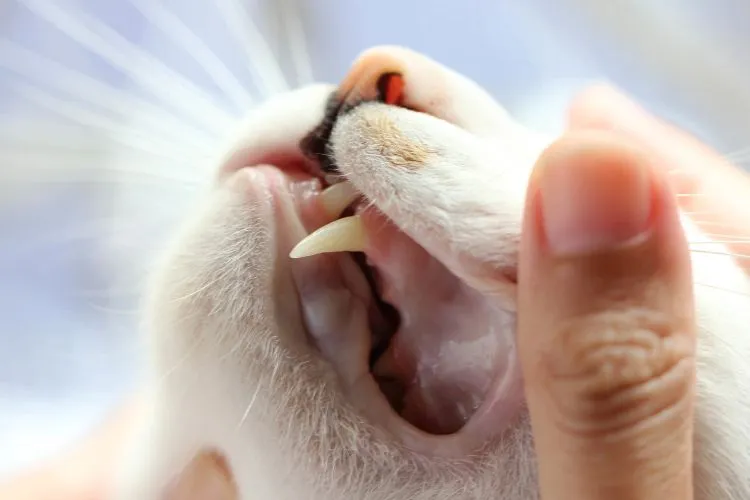
This article will unearth common dental diseases in adult cats, offering insights into symptoms, causes, and proactive measures to promote feline oral health.
🐾 Common dental diseases in adult cats
As cat caregivers, it’s crucial to recognize the signs of feline dental diseases, understand their underlying causes, and implement stringent preventive arrangements.
Here we’ve compiled details about some of the common dental diseases in adult cats that can affect them.
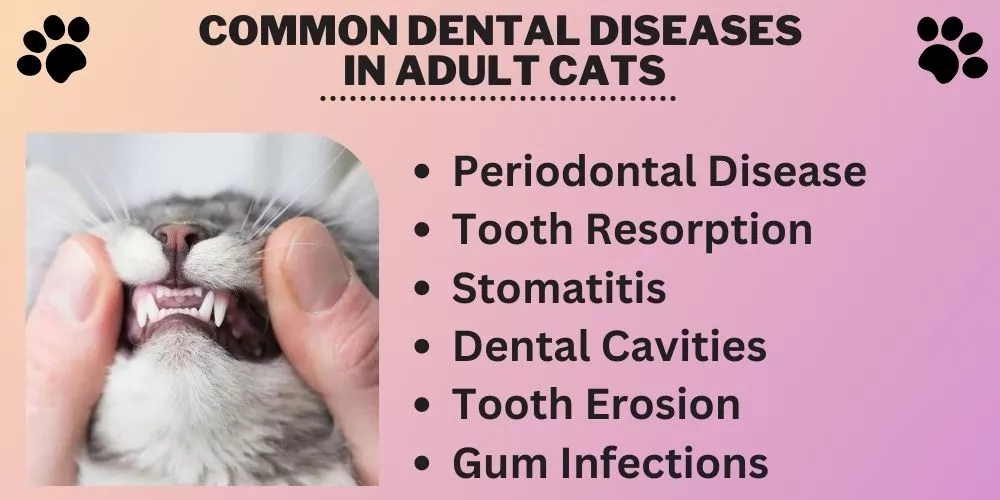
1. Periodontal Disease
Periodontal disease, or gum disease, is cats’ most prevalent dental ailment. Bacteria and food bits combine to form plaque on the cat’s teeth, culminating in tartar formation.
If left unidentified and untreated, it can lead to inflammation and damage the structure supporting the teeth, leading to tooth loss. Monitor for bad breath, red or swollen gums, and difficulty chewing.
2. Tooth Resorption
Tooth resorption, also known as FORLs (Feline Oral Resorptive Lesions), is when a cat’s body begins to reabsorb its teeth. This usually begins at the enamel and can progress to the tooth’s root if not intervened.
This widespread condition causes tremendous pain, though cats often mask the discomfort. Manifestations include bleeding from the mouth, increased drooling and inconsistent eating habits.
3. Stomatitis
Also known as feline Chronic Gingivostomatitis is a severe inflammatory condition that mostly affects a cat’s gums but can spread to the throat and oral cavity if left untreated. Stomatitis stems from an overactive immune response to plaque.
Cats with this burden suffer extreme pain. Their symptoms often include dramatic weight loss, excessive drooling, and a noticeable decrease in grooming behavior.
Sure, I’ll provide a detailed breakdown of each one.
4. Dental Cavities
Though uncommon in cats compared to humans, dental cavities nonetheless occur. This results from enamel demineralization from bacteria that increase in the mouth.
The bacteria metabolize dietary sugars and produce acids, destroying enamel and forming cavities. Symptoms might not be evident until the damage is severe, highlighting regular check-ups’ importance.
5. Tooth Erosion
Tooth erosion in cats, also known as tooth wear, is the gradual loss of tooth structure. This process occurs due to acids in the cat’s diet or stomach acid, especially when stomach maladies co-exist.
Tooth erosion can result in tooth sensitivity and cosmetic concerns from discolored teeth. Owners must watch for behavioral changes indicating discomfort during eating or abnormal chewing habits.
6. Gum Infections
Gum infections, such as gingivitis, arise from inflammation of the gums due to plaque build-up. Bacteria present in plaque contribute to gum disease by irritating the gum tissue. If left untreated, it can progress to periodontitis and cause damage to teeth and underlying bone.
Cats with gum disease might display symptoms such as red, swollen gums or bleeding upon brushing or biting into hard food.
Prevention of these issues lies in regular dental maintenance and care. Brushing your cat’s teeth, feeding them a dental-friendly diet, and addressing any co-existing health issues can readily reduce these dental disease risks.
Remember, regardless of the underlying oral discomfort, cats are excellent at hiding pain, so regular veterinary check-ups remain critical in maintaining their overall dental health.
🐾 Cat teeth problems symptoms
Cats are known for their rugged independence and stoic nature, often eclipsing any underlying health issue.
So recognizing the symptoms of cat teeth problems is crucial to ensure adequate care. Here are some common indications of dental issues in cats:
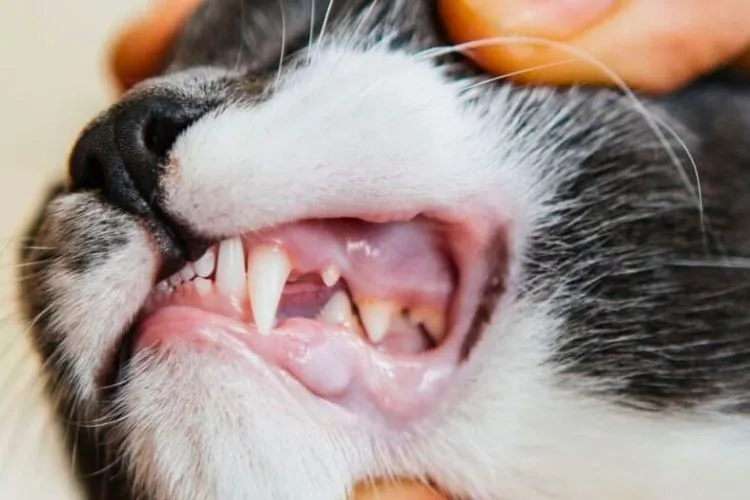
- Bad Breath (Halitosis): Cats’ breath doesn’t smell wonderful on a good day, but if it becomes noticeably foul, it strongly indicates an underlying dental problem. Bad breath in cats could be a symptom of periodontal disease or oral infection.
- Change in Eating Habits: If your cat suddenly loses interest in its food or eats less, it might be experiencing dental pain. Moreover, dropping food, excessive chewing on one side, or discarding larger chunks of food than usual are further signs of oral distress.
- Pawing at the Mouth: Any repeated, unusual face or mouth pawing suggests discomfort in a cat’s oral cavity. Such behaviour should never go unchecked, whether it’s a toothache, gum disease, or a foreign body lodged in the mouth.
- Swollen or Bleeding Gums: Swollen, red, or bleeding gums are typical symptoms of gum disease. Accompanied by bad breath, this should raise immediate red flags for caregiving owners.
- Excessive Drooling: Constantly drooling, especially if blood-tinged, can indicate a dental problem, specifically oral pain. Tooth resorption, oral masses, or stomatitis can manifest this way.
- Visible Plaque or Tartar: If your cat allows, open its mouth and inspect the teeth. Brownish-gold buildup at the base of the teeth indicates plaque or tartar accumulation. This could lead to periodontal disease if left untreated.
- Weight Loss: A significant or sudden weight loss in your feline companion may result from oral discomfort, making eating painful. Though it is a non-specific symptom, it warrants a comprehensive veterinary evaluation.
Understanding these symptoms is only part of the solution. Cats, unlike humans, can’t express their discomfort orally. Therefore, regular veterinary checkups and meticulous home care are vital to ensure their dental health.
🐾 What to feed a cat with gum disease?
Feeding a cat with gum disease can be complex, as their oral pain and discomfort may discourage them from eating. It’s essential to consult your veterinarian for a tailored plan specific to your cat’s needs.
The following guidelines will assist in adjusting your cat’s diet to ensure adequate nutrition during this challenging time.
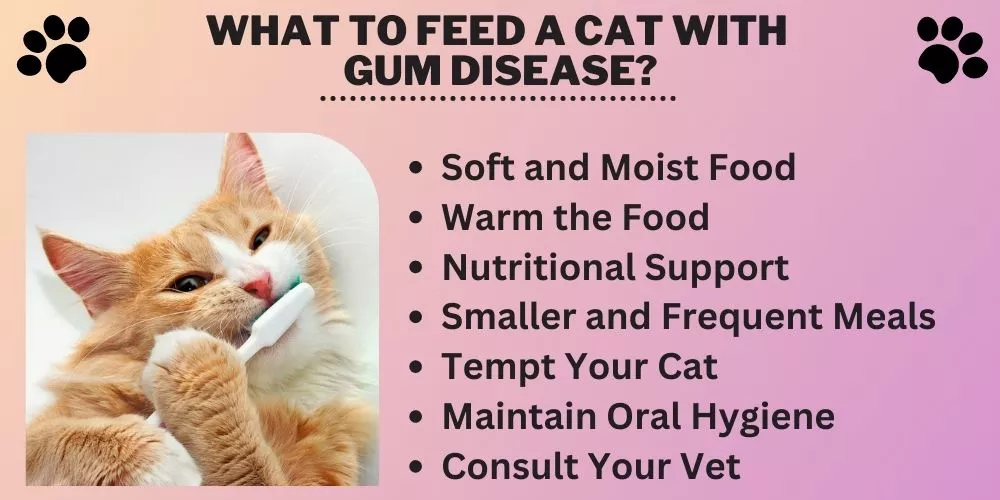
1. Soft and Moist Food
Switch to a softer, moist, or wet diet, as it’s gentler on your cat’s inflamed gums and easier to chew. Canned cat food, high-quality pate-style products, or adding water to dry kibble can help.
Avoid food with large chunks, as this requires more effort to break down, potentially exacerbating the pain.
2. Warm the Food
Gently warming your cat’s food enhances its aroma and makes it more palatable and more comfortable to eat if its gums are sensitive to cold or hot. Ensure it’s not overheated or hot to avoid damaging your cat’s tender mouth.
3. Nutritional Support
Cats experiencing gum disease may lose their appetite and suffer weight loss, leading to poor nutrition. Consult your vet to establish an appropriate dietary plan that supplies the necessary vitamins, minerals, and calories.
They may also recommend nutritional supplements like vitamin B or probiotics to strengthen their immune system.
4. Smaller and Frequent Meals
Reducing the quantity and increasing the frequency of meals can encourage your cat to eat more consistently. If your feline companion struggles with a full plate, try dividing it into smaller portions throughout the day.
5. Tempt Your Cat
Experiment with more enticing and flavorful options if your pet’s appetite isn’t steady. Adding liquid from canned tuna or low-sodium chicken broth can make their food more delicious.
Cat food with higher fat content is usually more palatable and can help compensate for lowered calorie uptake. Keep track of your cat’s food preferences and adjust accordingly.
6. Maintain Oral Hygiene
Brushing your cat’s teeth, using dental treats, or feeding them a dental care-specific diet (prescribed by a vet) will help slow gum disease progression and prevent further complications.
7. Consult Your Vet
Cats’ dietary requirements vary depending on age, breed, and pre-existing health conditions. Collaborate with your veterinarian to develop the optimal feeding regime for your cat.
In conclusion, feeding a cat with gum disease requires a dedicated approach to ensure they receive the necessary nutrition while accommodating their discomfort. Soft, moist food, smaller meals, and tempting enticements make their meals more manageable and enjoyable.
Lastly, consult your veterinarian to customize a feeding plan for your cat’s specific requirements.
🐾 Treatment of Dental Disease in Cats
Just as humans need to pay attention to their dental health, so do cats. But when dental issues arise, owners must know potential treatment options for their beloved companions.
Here are some of the typical therapeutic interventions for dental disease in cats:
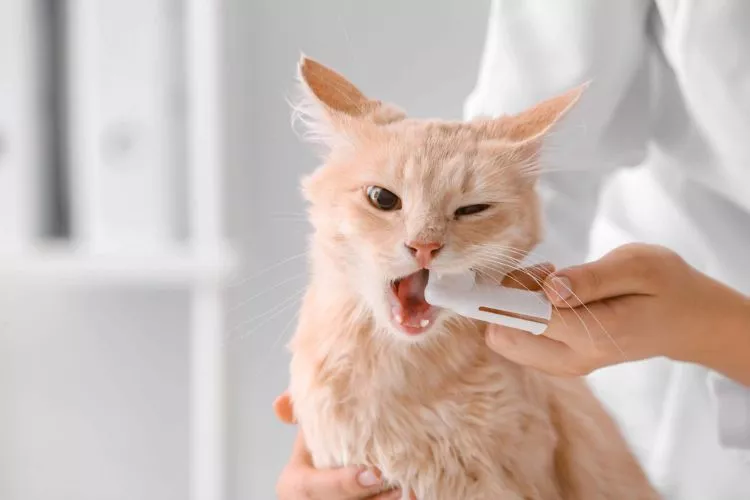
- Dental Cleaning: A professional dental cleaning is the first line of treatment for most oral diseases. This procedure involves scaling (removing dental plaque and tartar) and polishing the teeth, often requiring general anesthesia. A veterinarian or a well-trained veterinary dentist should always perform this.
- Tooth Extraction: In some severe cases, tooth extraction may be the best option when tooth resorption or advanced periodontal disease is present. Tooth extraction relieves pain and prevents the possible spreading of the infection to other organs through the bloodstream.
- Oral Surgery: In cases of oral tumors, cysts, bone infections, or severe jaw fractures, oral surgery may be required. A specialized veterinary surgeon or a board-certified veterinary dentist should conduct these procedures.
- Medications: Antibiotics and anti-inflammatory drugs can be prescribed to manage infection and inflammation associated with dental diseases. Cats with stomatitis, an extreme form of oral inflammation, could require immune-modulating medications. Always follow your vet’s instructions for administering medications.
- Dental Diet & Chews: Specific dry diets designed to clean the teeth as the cat chews are available can aid your pet’s dental treatment plan. Similarly, dental chews are made to scrape off plaque and tartar accumulation from teeth, though these should only supplement regular dental cleanings.
- Regular Home Care: Home dental care, including brushing your pet’s teeth with a toothpaste specially created for cats, is integral to treating dental disease. It’s vital for slowing the progression of dental disease and maintaining dental health after professional cleanings.
- Fluoride Treatment: Along with your cat’s dental cleaning, your vet may apply a substance that contains fluoride to each tooth to decrease the rate of future plaque build-up. This strengthening agent can help to prevent dental decay.
Remember, regular check-ups with a vet are essential for maintaining good oral health in cats, particularly because they are skilled at masking pain and discomfort. The earlier a problem is identified, the sooner it can be appropriately treated.
Conclusion:
Dental diseases in adult cats, including periodontal disease, tooth resorption, and stomatitis, pose serious threats to their overall health.
While cats are adept at hiding discomfort, mindful owners can identify symptoms, such as bad breath, changes in eating habits, and swollen gums.
Regular home dental care, professional check-ups, and appropriate diet adaptations are effective frontline defences.
When dental disease develops, interventions like professional cleaning, tooth extractions, and oral medications effectively treat symptoms and major side effects.
Ultimately, the best approach is proactive preventative care to ensure the long-term oral health of your feline companion.
